Display, Case and Peripherals
We have covered the core components for all of the systems, so now you need a box to put everything in, a power supply to get everything running, as well as a display, speakers, keyboard, and mouse. If you already have a decent computer system, you might want to reuse some of your existing parts, but it might be easier to simply buy a new case and power supply so that you can sell off your old system (or add a second full computer as the case may be). We have four configurations for you to choose from, ranging from an upper midrange selection all the way up through the no holds barred ultra high-end setup. While all four could be used with any of the computer systems listed in this guide, the higher-end parts you choose for your main components the more you should probably spend on the remainder of the system. Of course, you do not need to use all of the choices from one table; if you want to get an ultra high-end display but use baseline components for the rest of your system, there's nothing stopping you from doing so. Mix and match as you see fit!
| Base High-End Case and Accessories |
| Display |
Acer AL2216Wbd 22" 5ms 1680x1050 |
$339 |
| Case |
Antec Solution SLK3000-B |
$52 |
| Power Supply |
Seasonic S12-500 500W |
$113 |
| Keyboard and Mouse |
Microsoft Comfort Curve 2000 with Optical Mouse |
$28 |
| Speakers |
Logitech X-530 5.1 |
$55 |
| Total |
$587 |
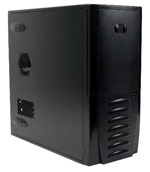 |
Our baseline recommendation has many similarities with the upgraded midrange configuration we used in our last buyers guide, including the use of the same 22" widescreen display from Acer and the Microsoft keyboard and mouse combo package. We have chosen a slightly different case and power supply, although the choice of case is going to be largely based on personal preference. The Antec SLK-3000 case is your classic steel Antec chassis with a black paint job: it's durable, easy to work with, and it includes a reasonably quiet rear 120mm fan with an additional 120mm fan mount at the front of the case. A second fan isn't absolutely required, but adding a lower RPM fan can help ensure that your components stay cool. As we are using multiple graphics cards in all the configurations, we felt a good-quality power supply was a required starting point. While just about any 500W or higher rated PSU is going to be sufficient, we wanted something relatively quiet that we were confident would last a long time.
(Ed: And we changed from the original PSU choice due to user feedback...) We selected the Seasonic S12-500 to go with the Antec case, as Seasonic is one of the most highly regarded PSU manufacturers around. 500W might seem low to some, but this is truly a 500W PSU with a high efficiency; it can really output 500W to all the peripherals - more than enough for the systems listed here today - and it will do so without drawing substantially more power from the outlet. We also added some basic 5.1 speakers from Logitech - something we omitted in the previous buyers guide.
(Ed: Sorry!) For the basic builds, we feel most users will be fine using integrated audio, so we are not listing a sound card, but you can see some options below.
| Upgraded High-End Case and Accessories |
| Display |
Acer 24" AL2416Wd 6ms 1920x1200 |
$686 |
| Case |
LIAN LI PC-7B plus II |
$100 |
| Power Supply |
OCZ GameXStream OCZ700GXSSLI 700W |
$130 |
| Keyboard and Mouse |
Logitech Keyboard and Mouse - Wireless + Rechargeable |
$56 |
| Sound Card |
Bluegears b-Enspirer |
$106 |
| Speakers |
Cyber Acoustics A-5640rb 5.1 |
$100 |
| Total |
$1178 |
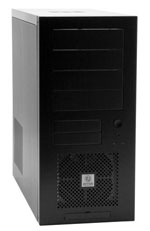 |
Stepping up one notch, we've moved up to a 24" LCD from Acer, sporting a native 1920x1200 resolution with a fast 6ms response time. With all the money spent on upgraded graphics cards, there's no point in not having a high-end display to help keep them busy! For the case, we chose the Lian Li PC-7B black aluminum enclosure. Lian Li has always been known for building high-quality cases, and this is no exception. Like the Antec we selected above, it includes two 120mm fan mounts at the front and rear of the case, only this time both fans are included. We upgraded the power supply one more notch to a 700W model, this time going with the OCZ GameXStream 700W as it is presently the lowest priced quality 700W PSU available. Thermaltake, Fotron Source, and several other manufacturers offer similar power supplies - in fact, most of these power supplies are simply tweaked Fotron Source designs, so if you can find one of those for less money there's little difference other than the name on the side of the PSU. For the input devices, we switched to a wireless Logitech keyboard and mouse, with the mouse including a recharging stand. Some people have other preferences as far as keyboards and mice go, so get what you're comfortable with.
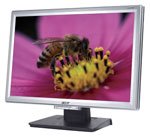 |
We've also upgraded the speakers, and we added a Bluegears b-Enspirer soundcard. A lot of you may not have heard of this soundcard yet, but it is definitely one to consider. It uses the new C-Media Oxygen HD CMI8788 audio chip and features real-time Dolby Digital and DTS encoding support. This is a great soundcard for anyone looking to put together an HTPC system, or anyone looking for better than integrated audio without the Creative Labs name. Feel free to upgrade the speakers to something better or use your home stereo system in order to take full advantage of this soundcard. If you're primarily concerned with gaming audio, the Sound Blaster X-Fi is still the better choice, but for light gaming and home theater use the Bluegears b-Enspirer is an excellent alternative.
| Upgraded #2 High-End Case and Accessories |
| Display |
Dell 2407WFP 24" 6ms GTG 1920x1200 |
$720 |
| Case |
Antec Performance I P180 |
$125 |
| Power Supply |
OCZ GameXStream OCZ700GXSSLI 700W |
$130 |
| Keyboard and Mouse |
Logitech MX3000 Wireless + Laser Mouse |
$63 |
| Sound Card |
Creative X-Fi XtremeMusic |
$114 |
| Speakers |
Logitech Z-5300e 5.1 |
$139 |
| Total |
$1291 |
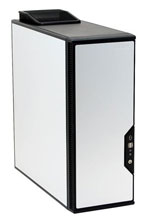 |
Most of the differences between this upgraded version and the previous upgraded version are slight. We've chosen the Dell 2407WFP 24" LCD, which we think looks a little bit nicer than the Acer, and it also includes a better stand and an integrated flash card reader. Are any of those changes required? No, but some of you will prefer the Dell display, and if you wait you might actually be able to find it for less money when Dell puts on one of their classic sales. We changed the case to an Antec P180, going for silver this time because not everyone likes black. (Make sure you get an appropriate optical drive faceplate if you choose this case!) The power supply remains the same, while we ditched the rechargeable wireless mouse for a wireless laser mouse. Finally, we upgraded the speakers another step to the Logitech Z-5300e. A little bit more money, a little bit better sound quality. We also chose a more gaming-centric sound card in the Creative Sound Blaster X-Fi XtremeMusic, which we would assume all of you are familiar with by now.
| Ultra High-End Case and Accessories |
| Display |
Dell 3007WFP 30" 11ms GTG 2560x1600 |
$1450 |
| Case |
Cooler Master Stacker 830 |
$243 |
| CPU Cooling |
Scythe Infinity |
$60 |
| Power Supply |
SilverStone SST-ST85ZF 850W |
$279 |
| Keyboard |
Microsoft Natural 4000 |
$43 |
| Mouse |
Logitech MX Revolution |
$90 |
| Sound Card |
Creative X-Fi Platinum |
$175 |
| Speakers |
Logitech Z-5500D 5.1 Digital Speakers |
$223 |
| Total |
$2563 |
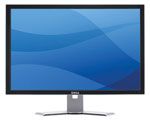 |
The Ultra accessories package is a great complement to the ultra high-end Intel configuration. In a similar fashion, we have maxed out just about every component, sometimes at significant expense. We have chosen the Cooler Master Stacker 830 for our top configuration, as it has a spacious interior and an attractive and easy to use design that's suitable for even the most high-end configurations. Yes, you could buy a different case, and as we often state what case is "best" is largely a matter of personal preference. For the display, the best computer deserves the best LCD currently available, so we have selected the Dell 3007WFP 30" LCD with a native 2560x1600 resolution (or WQXGA if you prefer). Definitely don't skimp on your GPU selection if you choose to go with this large monitor and plan on gaming at the native resolution!
We also jumped up to an 850W power supply from Silverstone, which costs almost twice as much as the 700W OCZ.
(Ouch!) However, with rumors circulating that the next generation high-end graphics cards from NVIDIA and ATI will
require even more power than the current models, we felt that any ultra high-end system needed a power supply equal to the task. (You could jump up to a PC Power & Cooling Turbo-Cool 1000W PSU if you really want to go extreme, but be prepared to fork over nearly $500 for the privilege!) The soundcard has been bumped up to the platinum edition of the X-Fi, which adds a 5.25" bay that provides front panel connections but is otherwise the same as the other X-Fi cards. For the speakers, we moved up to the Logitech Z-5500 digital speakers, eliminating the interference that can be generated by all of the electronic noise inside your computer case. Finally, for the user interface we went with Microsoft's Natural 4000 keyboard and coupled that with
Logitech's Revolution MX mouse, both of which are arguably best in class peripherals. However, personal preference still plays a role, so you might want to try out these devices in person at your local computer store.
CPU Cooling
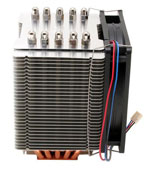 |
One item that we added to the ultra configuration that is worth considering for any of the system builds is an aftermarket heatsink to help keep your processor cool. If you are looking for the HSF that we currently feel is the best air cooling available, look no further than the Scythe Infinity. It is absolutely massive and definitely won't fit in every computer case out there - or on every motherboard - but if you are serious about overclocking then the $65 is money well spent. Another good alternative is the Tuniq Tower 120, which is unfortunately out of stock everywhere right now. We consider the Scythe Infinity to be the better CPU cooler, but the Tuniq Tower 120 is very good and might cost a bit less. Another competing solution (that's just as large as the Infinity) is the Thermalright Ultra-120, which typically equals the other two in cooling prowess and may cost a bit more or less depending on where you find it. For cases and motherboards that aren't quite as spacious, Zalman and Thermalright offer reasonably priced CPU coolers that will still outperform the stock heatsinks from both AMD and Intel.

















45 Comments
View All Comments
Zebo - Tuesday, October 10, 2006 - link
Anandtech really needs to start doing monitor tests again. I don't know if you used those Acers but they suck bad. And the Dell 24" suffers from serious input lag and poor view angles like the TN Acers. LCD's are not a commodity where you can graph price/size and pick your winner. Does 8 bit means nothing? Color shift? Input lag? Lying specs vs. real specs? Good viewing angles? LCD scaling for gamers?The 30" Dell is pretty decent as it's an IPS but not overdriven like the new HP so it's slow.
JarredWalton - Tuesday, October 10, 2006 - link
I've got both Dells, and they work fine for everything I do. Overdriving displays is mostly just playing the numbers game. If you can see pixel lag on any of the Dell LCDs mentioned, then you can probably see pixel lag on virtually every LCD on the market. I will be doing some LCD reviews in the near future, but so far I have far bigger issues with prices than I do with performance. I just wish I could get an LCD that ran at a high refresh rate in order to avoid tearing when vsync is disabled. Unless you do professional imaging work where having accurate color values is absolutely necessary, most LCDs will get the job done. As for the Acer displays, they did get put on the bottom of the pricing chart for a reason, and I don't think they are the highest quality displays available. They aren't the worst displays available, and without spending twice as much money it is unlikely that he will seek dramatically better performance or colors in the same size display.limiter - Tuesday, October 10, 2006 - link
I agree on the price, I bought a cheap (under $275), BenQ FP202W 20.1in Widescreen display that got panned by Tom's Hardware as the worst 20.1in widescreen monitor they've ever seen, yet I think it's great. I don't see lag, or the other problems mentioned in their review. I went from a 19in CRT so it's not like I was going from a 15in at 32ms to 8ms and that's why I think it's great. Maybe I just have bad eyes, but I'd buy it again.JarredWalton - Tuesday, October 10, 2006 - link
That's a perfect case in point. While it is definitely possible to measure differences between LCDs, the simple truth is that most people can't tell the difference without specialized hardware to measure values. For example, a display that has colors that are off by 10% might not look as good next to a display that has accurate colors. However, if you're viewing them individually in separate rooms, you're going to have a difficult time determining which is better using just your eyes. The lighting in a room often has more of an impact on the display visuals for typical users than the display itself.Howard - Monday, October 9, 2006 - link
The efficiency of a PSU has nothing to do with its actual power output.JarredWalton - Monday, October 9, 2006 - link
No, and I don't believe I said it does. It has to do with how much power is used internally in the conversion process, so a 70% efficient 600W PSU could in theory draw 857W and an 85% efficient 600W PSU would only draw 706W - something like that.I guess the text implied that the efficiency meant it could output 500W. What I meant is that it can do 500W output, and it can do it at a high efficiency. There are plenty of "500W" PSUs out there that would fail if you really tried to pull 500W from them. I'll clear up the text....
yyrkoon - Tuesday, October 10, 2006 - link
Actually, I believe its more like power thats NOT lost to heat while being converted to DC, from AC. Feel free to correct me if Im wrong though :)BigLan - Monday, October 9, 2006 - link
Given the ati-amd merger, the AMD god box uses nvidia sli while the Intel box uses ATi crossfire. I suspect that in a year that situation will be reversed.Good guide btw, it's nice to dream about building a system like this, but I'd stick with my Scythe Ninja for a HSF.
limiter - Monday, October 9, 2006 - link
How much of this hardware did you guys test together? I wonder especially about the memory and the optical drives simply because there seem to be a number of modules and drives out there that either don't work, or don't work as well as they should with the p965/975x motherboards. I'm looking at building a new system soon and really appreciate these guides, but I would like to see either confirmation that at least the memory was tested with the motherboard/processor combo listed, or that someone else has tested it and you are going off that... I guess just for peace of mind before buying anything. The motherboard manufacturers list a small number of compatible modules, ASUS being the worst.Gary Key - Monday, October 9, 2006 - link
The majority of the components have all been tested on a large cross-section of boards. Some components work better in certain boards (even though the chipsets are the same) than others. Memory was a very weak area in the P965 launch and it was not the budget memory at the time, it was the upper end memory that was having issues. My opinion on the subject matter is that both the memory and motherboard suppliers had equal issues. The majority of it has cleared up now although it is difficult to understand why certain memory modules and bios updates still have issues playing nice with each other. As far as optical drives, please let us know which one is having an issue, tried over 18 different optical drives from a Kenwood TrueX to a Pioneer Blu-ray without an issue on our current collection of 965/975 boards. At least 11 different hard drives have been used also at this time.